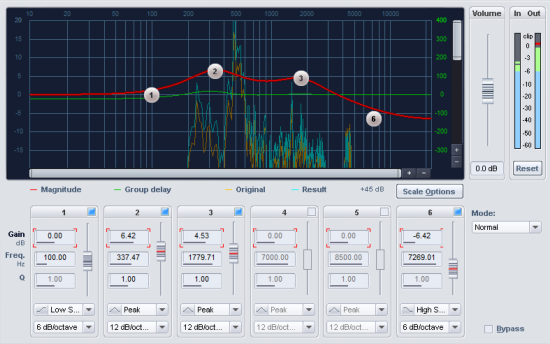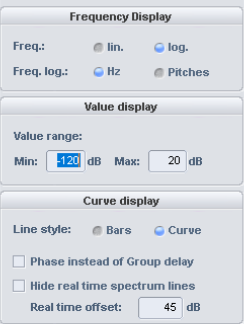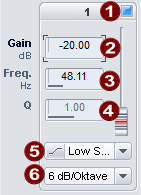EQ116

The EQ116 is a 6-channel fully parametric equalizer for influencing the frequency response of audio signals.
Graphic displays
The upper part of the dialog contains the filter graphic. This graphic provides you with several frequency-related information:
- Magnitude: The amplitude increase or decrease resulting from the individual band settings.
- Group delay/Phase: (switchable in the scale options). The group delay describes the frequency-dependent time delay when the signal passes through, while the phase shows the dependence of the phase from the frequency.
- Original: This curve shows the original frequency response in real time.
- Result: This curve shows the frequency response after processing by the effect.
You customize the display of the filter graph in the Scale Options dialog and by using the horizontal and vertical scroll bars.
|
|
|
Volume: Use this control to adjust the level to compensate for level changes caused by the filter.
In / Out indicators: The peak meters show the input and output level in dB.
Reset (meter): Reset the in and out displays.
Editing the Characteristic Curve
Filter graphic: The parameters Gain and Frequency of a band can be changed in the graphic by moving the corresponding circle. The bandwidth (Q) can be adjusted with the mouse wheel.

|
|
In the input field you can change the values of the parameters by dragging the mouse vertically or enter numerical values. |
A selected parameter can also be adjusted using the slider next to the parameters. You always select the parameter for all bands together.
Over the input field and the slider you can also use the mouse wheel for value changes. While doing so, hold the Shift key for finer changes.
|
|
|
Band On/Off: Switching the band on and off. In the filter graphic, the corresponding circle also disappears. |
|
|
Gain: These controllers allow you to raise or lower the filter. With a gain of 0dB the band is also deactivated (neutral setting). |
|
|
|
Freq. (Frequency): Here you set the cutoff frequency of the individual filters between 10 Hz and 24 kHz. |
|
|
|
Q (Bandwidth): Here you set the bandwidth of the individual filters between 0.10 and 10. |
|
|
|
Type: Here you set the filter type between Peak, Low Shelving, High Shelving, High Pass and Low Pass. |
|
|
|
Slew Rate (slope): For High Pass and Low Pass , choose between a slope of 6dB/octave, 12dB/octave, 24dB/octave or 36dB/octave. For Low shelving and High shelving, select between 6 dB/octave and 12 dB/octave. The filter type Peak is fixed at 12dB/octave. |
Mode
With Mode you set the working mode of the EQ116.
-
Normal: Minimum phase EQ, corresponds to the operation of the 4-band parametric equalizer of older Sequoia versions (compatibility mode ).
-
Oversampling: The effect internally works with a higher sample rate compared to the first mode. Especially for higher frequencies, a more precise frequency response can be reached, and fewer aliasing artifacts arise. The disadvantage is that this mode requires more computing power.
-
Linear phase: The equalizer works without frequency-dependent phase shifts. A fundamentally different algorithm is used than in the first two modes. The Linear phase mode sounds more neutral and less colorful, and the amplitude of the overall signal is also less affected, since there are no amplification and cancellation effects due to the phase shift. However, the EQ requires more computing power in this mode. In addition, artifacts ("pre-ringing") can occur at higher frequencies when processing impulsive audio material.
In Linear phase mode, the parameters of the EQ116 cannot be automated.








